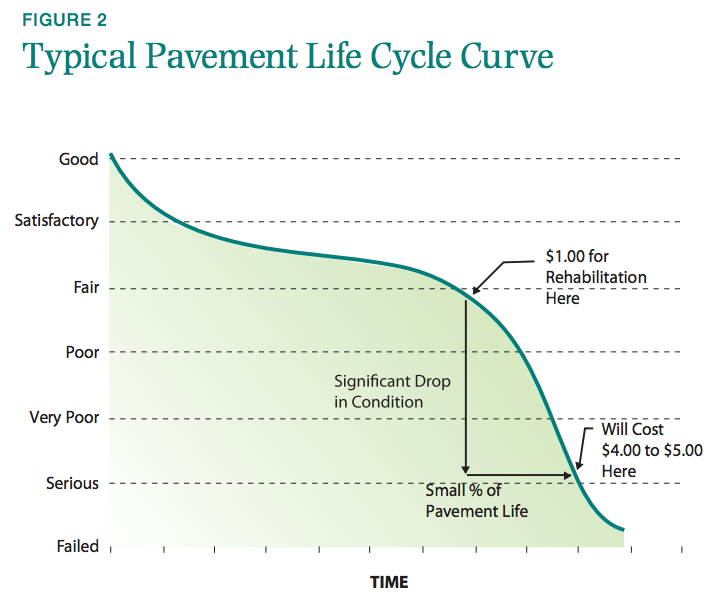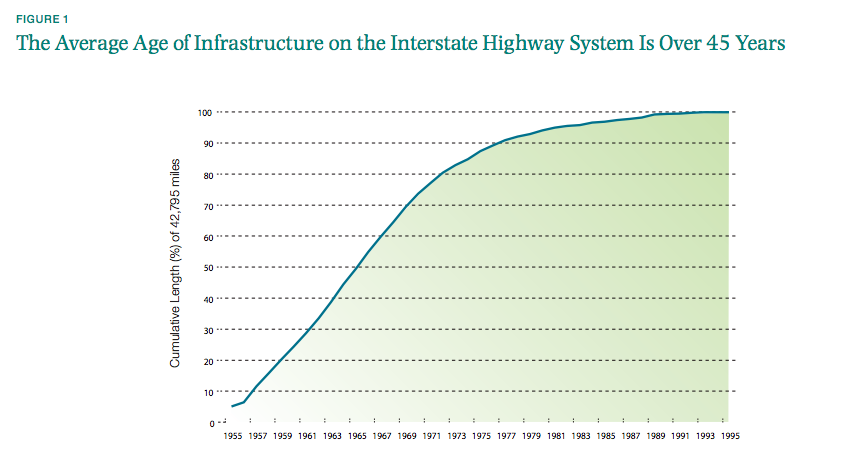BROOKINGS INSTITUTE
In his recent State of the Union address, President Obama proposed a “Fix-it-First” approach to investing in our nation’s ailing infrastructure. This approach recognizes the value of the well-traveled network of roads and bridges that make up our nation’s existing highway system, and prioritizes the maintenance and rehabilitation of our deteriorating system.
In “Fix It First, Expand It Second, Reward It Third: A New Strategy for America’s Highways,” a paper commissioned by The Hamilton Project at Brookings in 2011, authors Matthew Kahn and David Levinson argue that the repair, maintenance, rehabilitation, reconstruction, and enhancement of our existing roads and bridges is the best way to maximize the benefits of infrastructure spending. When first constructed decades ago, the interstate highway system led to economic gains by connecting people and businesses. The full benefits of that system has eroded as roads and bridges have deteriorated, contributing to congestion, longer travel times, increased wear and tear on vehicles, and even accidents. A fix-it-first approach would recoup the value we’re missing from using our current system inefficiently.
…
Fix It First, Expand It Second, Reward It Third: A New Strategy for America’s Highways
THE HAMILTON PROJECT
 Bridges, roads, and other transportation infrastructure are crucial for facilitating trade within, between, and across states. The development and expansion of the National Highway System has facilitated trade and linked markets: markets that were once only local—from manufacturing and wholesale operations to common retail goods—are now national. The impacts of infrastructure extend from the national economy to many aspects of Americans’ everyday lives, from the length of commutes, the quality of the air, and the livability of American neighborhoods. However, estimates suggest that our valuable transportation network is degrading—the American Society of Civil Engineers estimates we are currently spending $110 billion too little each year to maintain the system at current performance levels. This accumulating wear and tear increases travel times, damages vehicles, and can lead to accidents that cause injuries and fatalities. Although the United States currently invests close to $150 billion annually on infrastructure across all levels of government, a large fraction of that is for new infrastructure projects that appear to be producing fewer results in terms of economic activity and quality-of-life improvements.
Bridges, roads, and other transportation infrastructure are crucial for facilitating trade within, between, and across states. The development and expansion of the National Highway System has facilitated trade and linked markets: markets that were once only local—from manufacturing and wholesale operations to common retail goods—are now national. The impacts of infrastructure extend from the national economy to many aspects of Americans’ everyday lives, from the length of commutes, the quality of the air, and the livability of American neighborhoods. However, estimates suggest that our valuable transportation network is degrading—the American Society of Civil Engineers estimates we are currently spending $110 billion too little each year to maintain the system at current performance levels. This accumulating wear and tear increases travel times, damages vehicles, and can lead to accidents that cause injuries and fatalities. Although the United States currently invests close to $150 billion annually on infrastructure across all levels of government, a large fraction of that is for new infrastructure projects that appear to be producing fewer results in terms of economic activity and quality-of-life improvements.
The way the federal government allocates money for transportation infrastructure investments is one reason why the United States is experiencing a maintenance shortfall and falling returns on new investment. Federal highway infrastructure spending is allocated based on a series of subjective criteria that typically do not require any stringent analysis of expected benefits versus costs. Because there is often public pressure to build new projects using scarce funds, adding capacity often comes at the expense of supporting and enhancing existing infrastructure. To continue to enjoy the level of network performance that Americans often take for granted, maintenance, preservation, and enhancement of this existing system is urgently needed.
Meanwhile, a key constraint with the current system is peaktime congestion. Highway drivers impose costs on others in the form of longer commute times and increased pollution, especially during rush hour and other peak driving times. Drivers do not have to take into account these costs when making their driving decisions on most roads in America. This lack of clear price signals leads some roads to be overused, resulting in too much congestion and pollution. While this congestion may indicate that more capacity is needed, it also may indicate that better pricing of the existing infrastructure is necessary to encourage users to take on the broader social costs of their travel during these peak times.
In a discussion paper from The Hamilton Project, “Fix It First, Expand It Second, Reward It Third: A New Strategy for America’s Highways,” Matthew Kahn of the University of California, Los Angeles, and David Levinson of the University of Minnesota propose a new framework to support and improve our nation’s highway infrastructure in order to shift the focus of infrastructure spending toward the maintenance of our existing transportation system, and make certain that new transportation infrastructure is priced more efficiently and fairly. Specifically, Kahn and Levinson would reprioritize funding from the federal Highway Trust Fund (made up of the collections from highway tolls and the federal gas tax) so that all proceeds would be earmarked for existing infrastructure. This would provide an additional $12 billion annually for maintenance and improvement. Each state department of transportation would use rigorous analysis, including benefitcost tests, to allocate funds. New highway infrastructure would be financed from a new, independent institution, the Federal Highway Bank, that would award loans based on performance standards. Projects that meet or exceed their performance goals—from lowering congestion, to decreasing travel times, to lowering pollution—would be rewarded with a generous interest-rate subsidy.
About The Hamilton Project
www.hamiltonproject.org
“The Hamilton Project offers a strategic vision and produces innovative policy proposals on how to create a growing economy that benefits more Americans. The Project’s strategy reflects a judgment that long-term prosperity is best achieved by fostering economic growth and broad participation in that growth, by enhancing individual economic security, and by embracing a role for effective government in making needed public investments.”
Tags: Barack Obama, Brookings Institute, FIx-It-First, State of the Union, The Hamilton Project







 RSS Feed
RSS Feed